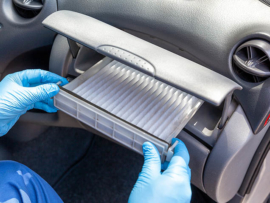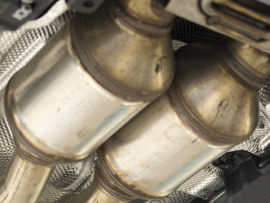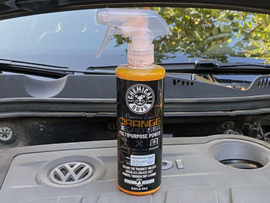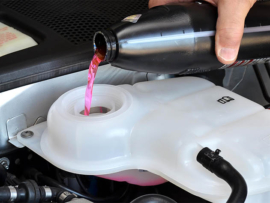Modern vehicles are equipped with various sensors that play a crucial role in monitoring and controlling engine performance. One such sensor is the upstream oxygen sensor (O2S), located ahead of the catalytic converter. Its primary function is to measure the concentration of oxygen in the exhaust gas, providing essential data to the ECU (Engine Control Unit) or Powertrain Control Module (PCM) for precise fuel control and reduced emissions.
The oxygen sensor compares the amount of oxygen in the exhaust to the surrounding air, generating a corresponding voltage that is transmitted to the PCM or ECU. To ensure accurate and timely readings, most vehicles use a heated oxygen sensor (HO2S), featuring a heating element that rapidly brings the sensor to its operating temperature. This quick warm-up allows the PCM (ECU) to use the sensor’s input early on, optimizing fuel control and reducing emissions effectively.
Code P0135 Fix Cost
The cost to fix code P0135 can vary depending on several factors, including the vehicle make and model, the location of the sensor, and whether you plan to do the repair yourself or take it to a professional mechanic. Here are some cost considerations had been determined on the date of publication:
- DIY Repair: If you have the necessary tools and skills, you can replace the oxygen sensor yourself. The cost of a new oxygen sensor can range from $20 to $100 or more, depending on the brand and quality. Keep in mind that some vehicles have multiple oxygen sensors, and the cost will increase if you need to replace more than one.
- Professional Mechanic: If you prefer to have a professional mechanic handle the repair, you’ll need to consider labor costs in addition to the price of the oxygen sensor. Labor rates vary depending on the location and the mechanic’s expertise, but it could be around $100 to $200 or more.
Considering these factors, the total cost to fix P0135 diagnostic trouble code could range from around $50 to $300 or more, depending on the vehicle and the repair approach you choose. It’s essential to get quotes from different mechanics or parts suppliers to find the best deal for your specific situation.
Additionally, if your vehicle is under warranty, the cost of the repair may be covered if the oxygen sensor failure is deemed a manufacturer’s defect.
OBD-II Code P0135 Diagnostics
To diagnose and address P0135 code effectively, focus on the O2 sensor heater circuit and the sensor itself. Heated O2 sensors generally have four wires, two of which are related to the heater circuit, while the other two deal with power and ground for the sensor.
- Start by disconnecting the O2 sensor connector and using a digital multimeter to test the heater circuit for power and ground. Consult your vehicle’s wiring diagram to identify the correct pins for testing.
- For the power side, with the black multimeter lead on ground and the other on the power feed, the reading should be close to battery voltage. If not, inspect the O2 sensor power supply and consult the wiring diagram to locate the circuit fault.
- For the ground side, connect the red multimeter lead to the battery positive terminal and the black lead to ground. A reading of about 12 volts indicates a healthy ground circuit. If not, examine the ground side of the wiring diagram to find and rectify the circuit fault.
- Finally, test the sensor heating element for high resistance or an open circuit using the ohms setting on your multimeter. Compare the resistance value to the specifications in the service information. If it’s outside the acceptable range or the meter reads OL (open circuit), replace the sensor.
By following the outlined steps and using the appropriate tools, you can effectively address this issue, ensuring your vehicle runs efficiently and meets emissions requirements. Maintaining a well-functioning O2 sensor is crucial for optimal engine performance and reduced environmental impact.
How To Fix DTC P0135?
Fixing code P0135 involves a systematic approach to diagnose and address the issue related to the O2 sensor heater circuit or the sensor itself. These steps could be used to resolve the problem:
- Confirm the Code: If your vehicle’s check engine light is illuminated and you suspect code P0135, use an OBD-II scanner to read and confirm the specific code.
- Gather Necessary Tools: Ensure you have the required tools, including a digital multimeter, a wiring diagram for your vehicle, and any replacement parts needed.
- Locate the Affected Sensor: Identify the location of the bank 1, sensor 1 oxygen sensor in your vehicle. It is usually positioned ahead of the catalytic converter and on the side of the engine containing cylinder №1.
- Disconnect the Sensor: To inspect the O2 sensor heater circuit, disconnect the O2 sensor connector first. This will allow you to access the wires and perform the necessary tests.
- Test the Heater Circuit Wiring: Using a digital multimeter, check the heater circuit for power and ground. Refer to the wiring diagram to identify the correct pins for testing. Measure the voltage between the power and ground pins to ensure proper electrical supply to the sensor. If there is no voltage, identify and repair any wiring issues in the power side of the circuit. Likewise, check for continuity in the ground side of the circuit.
- Inspect the Sensor Heating Element: Set your multimeter to the ohms setting and measure the resistance between the two heater circuit pins on the sensor side of the connector. Compare the resistance value to the specifications in the service manual. If the resistance is higher or the meter reads OL (open circuit), it indicates a faulty heating element within the sensor.
- Replace the Oxygen Sensor: If the O2 sensor’s heating element is faulty or has an open circuit, it’s best to replace the sensor. Ensure you get a compatible replacement for your vehicle’s make and model.
- Reconnect and Clear Codes: Once you’ve replaced the oxygen sensor, reconnect the O2 sensor connector. Use the OBD-II scanner to clear the fault codes from the vehicle’s memory.
- Test Drive and Monitor: Take your vehicle for a test drive to ensure that the check engine light remains off and that the engine is operating smoothly. Monitor the system for a few days to ensure the code doesn’t reappear.
By following these steps and performing the necessary tests, you can effectively fix Code P0135 and ensure your vehicle’s oxygen sensor operates correctly, contributing to improved fuel efficiency and reduced emissions. Look into the chapter above if you would like to address this fix to the professional mechanic or service station.
Related DTCs to P0135
There are some codes that likely would have been shown along with the aforementioned code: P0101, P0130, P0141, P0155, P0171, P0300, P0420.
We do an efforts to find, research and recommend the best products. So, we may receive commissions from purchases that you make after following the links in our product reviews.








Leave A Comment